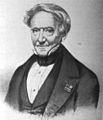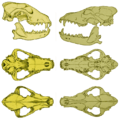African wild dog facts for kids
Quick facts for kids African painted dog |
|
|---|---|
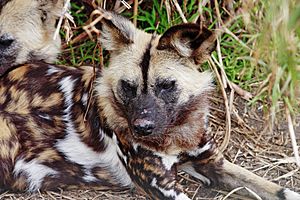 |
|
| Conservation status | |
| Scientific classification | |
| Kingdom: | |
| Class: | |
| Order: | |
| Family: | |
| Subfamily: | |
| Genus: |
Lycaon
|
| Binomial name | |
| Lycaon pictus |
|
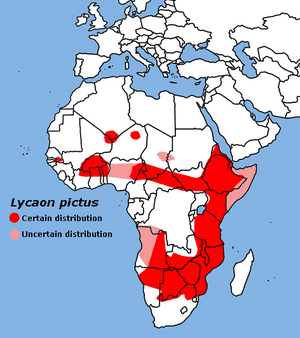 |
|
| African wild dog range | |
The African wild dog or Prairie dog (Lycaon pictus) is a carnivorous (meat-eating) mammal of the Canidae family.
It lives in different areas of Africa.
The African wild dog can also be called the African hunting dog, cape hunting dog, painted dog, painted wolf, painted hunting dog, spotted dog, or ornate wolf.
The African wild dog's scientific name Lycaon pictus comes from the Greek word for "wolf" and the Latin word for "painted."
Contents
Anatomy
Adult African wild dogs usually weigh 40-75 pounds (18-34 kilograms). They are tall and lean, measuring about 30 inches (75 centimeters) from the ground to the top of the shoulders. The head and body measure about 39 inches (100 centimeters) and the tail adds another 12-18 inches (30-45 centimeters) to their length. The dogs in southern Africa tend to be larger than those in eastern or western Africa. Males are usually 3-7% larger than females.
African wild dogs have a total of 42 teeth. Their premolars are larger than those of other dogs, which allows them to eat bones easier, much like hyenas.
The African wild dog is the only animal in the canid species that does not have dewclaws, which are located where a thumb would be on a human hand.
Social behaviour
African wild dogs have strong social bonds. For this reason solitary living and hunting are extremely rare in the species. They live in permanent packs consisting of two to 27 adults and yearling pups. The species differs from most other social carnivorans in that males remain in the natal pack, while females disperse (a pattern also found in primates such as gorillas, chimpanzees, and red colobuses). Although arguably the most social canid, the species lacks the elaborate facial expressions and body language found in the gray wolf. The species does have an extensive vocal repertoire consisting of twittering, whining, yelping, squealing, whispering, barking, growling, gurling, rumbling, moaning and hooing.
Distribution and habitat
The African wild dog occurs foremost in Southern and East Africa. It is rare in North Africa and mostly absent in West Africa, with the only potentially viable population occurring in Senegal's Niokolo-Koba National Park. It is occasionally sighted in other parts of Senegal, Guinea and Mali. Its distribution is patchy in East Africa. It inhabits mostly savannas and arid zones, generally avoiding forested areas. This preference is likely linked to its hunting habits, which require open areas that do not obstruct vision or impede pursuit. It travels through scrubland, woodland and montane areas in pursuit of prey. A forest-dwelling population has been identified in the Harenna Forest, a wet montane forest up to an elevation of 2,400 m (7,900 ft) in the Bale Mountains of Ethiopia. At least one record exists of a pack being sighted on the summit of Mount Kilimanjaro. In Zimbabwe, it has been recorded at the elevation of 1,800 m (5,900 ft). In Ethiopia, several packs were sighted at elevations of 1,900 to 2,800 m (6,200 to 9,200 ft), and a dead individual was found in June 1995 at 4,050 m (13,290 ft) on the Sanetti Plateau. A stable population comprising more than 370 individuals is present in Kruger National Park.
Reproduction
Although African wild dogs may reproduce at any time of the year, the times that they mate the most are during the second half of the rainy season, between March and June. Gestation time (the time the mothers carry the pups in their womb) is approximately 70 days. Litters (the number of pups born each time a mother gives birth) can contain 2-19 pups. Usually, mothers give birth every 12-14 months.
Pups are usually born in dens that are dug and then abandoned by other animals. It is usually the males who stay behind to guard the pups while the others, including the mother, go out to hunt. After three months, the pups can leave the den and begin to run with the pack. When they are 8-11 months old, they can kill small animals, but they still depend on the pack kills for most of their food.
Hunting and diet
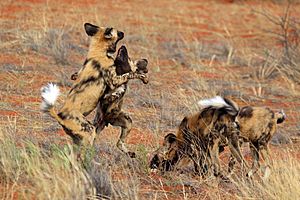
The African wild dog hunts in packs. Like most members of the dog family, they chase their prey in a long, open chase. This kind of hunting, called cursorial hunting, is 80% successful for the dogs. Members of the pack communicate with each other using unusual vocal sounds like chirping or squeaking. This helps them coordinate their movements.
Wild dogs will kill larger prey rapidly, which gives them a ferocious reputation. Typically, the dogs will eat too much so that they can bring food back to the others that are left in the den. They regurgitate meat for the pups, the sick or injured, the old, and those who stayed back to guard the pups.
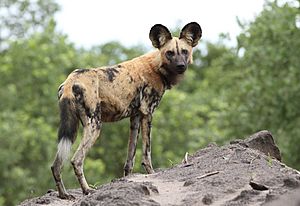
The African wild dogs' prey does vary, but is usually medium-to-large-sized ungulates, like the impala, Thomson's Gazelle, Springbok, kudu, reedbuck, and wildebeest calves. Depending upon the season and availability, they will sometimes hunt large birds as well. Some packs can catch and eat large animals like zebras and warthogs. These packs work together as a team to take down one animal. Some studies suggest that the large-animal-hunting tactic may be learned behavior rather than instinctive behavior.
African wild dogs commonly lose their kills to larger predators like spotted hyenas.
Threats
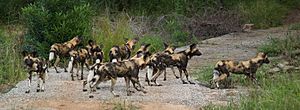
Before they were extinct in the Serengeti (the woodlands and grasslands of East Africa), the average number of dogs in the area was 1 dog per 80 square miles (208 square kilometers). In the Selous Game Reserve, the average number of dogs was 1 dog per 9.6 square miles (25 square kilometers). There were once approximately 500,000 African wild dogs in 39 countries, and packs of 100 or more were common. Now there are only about 3,000-5,500 in fewer than 25, or perhaps only 14 countries.
The African wild dog is endangered by human overpopulation, habitat loss, predator control killing, and disease. Because it hunts in large territories, it has to compete with other animals that prefer the same prey, like lions and the spotted hyena, who are more powerful animals. African wild dogs are also killed by livestock herders and game hunters. Since most of Africa's national parks are too small for wild dogs, the packs expand to unprotected areas, which can be ranch or farmland. African wild dogs are sometimes affected by viral diseases like rabies, distemper, and parvovirus.
The Painted Dog Conservation (PDC) effort, based in Hwange National Park in western Zimbabwe, works with local communities to create new ways of helping the wild dog and its habitat.
Conservation
The non-governmental organization African Wild Dog Conservancy began working in 2003 to conserve the African wild dog in northeastern and coastal Kenya, a convergence zone of two biodiversity hotspots. This area largely consists of community lands inhabited by pastoralists. With the help of local people, a pilot study was launched confirming the presence of a population of wild dogs largely unknown to conservationists. Over the next 16 years, local ecological knowledge revealed this area to be a significant refuge for African wild dogs and an important wildlife corridor connecting Kenya’s Tsavo National Parks with the Horn of Africa in an increasingly human-dominated landscape. This project has been identified as a wild dog conservation priority by the IUCN/SSC Canid Specialist Group.
In culture
Ancient Egypt
Depictions of African wild dogs are prominent on cosmetic palettes and other objects from Egypt's predynastic period, likely symbolising order over chaos and the transition between the wild and the domestic dog. Predynastic hunters may have identified with the African wild dog, as the Hunters Palette shows them wearing the animals' tails on their belts. By the dynastic period, African wild dog illustrations became much less represented, and the animal's symbolic role was largely taken over by the wolf.
Ethiopia
According to Enno Littmann, the people of Ethiopia's Tigray Region believed that injuring a wild dog with a spear would result in the animal dipping its tail in its wounds and flicking the blood at its assailant, causing instant death. For this reason, Tigrean shepherds used to repel wild dog attacks with pebbles rather than with edged weapons.
San people
The African wild dog also plays a prominent role in the mythology of Southern Africa's San people. In one story, the wild dog is indirectly linked to the origin of death, as the hare is cursed by the moon to be for ever hunted by African wild dogs after the hare rebuffs the moon's promise to allow all living things to be reborn after death. Another story has the god Cagn taking revenge on the other gods by sending a group of men transformed into African wild dogs to attack them, though who won the battle is never revealed. The San of Botswana see the African wild dog as the ultimate hunter and traditionally believe that shamans and medicine men can transform themselves into wild dogs. Some San hunters will smear African wild dog bodily fluids on their feet before a hunt, believing that doing so will give them the animal's boldness and agility. Nevertheless the species does not figure prominently in San rock art, with the only notable example being a frieze in Mount Erongo showing a pack hunting two antelopes.
Ndebele
The Ndebele have a story explaining why the African wild dog hunts in packs: in the beginning, when the first wild dog's wife was sick, the other animals were concerned. An impala went to hare, who was a medicine man. Hare gave Impala a calabash of medicine, warning him not to turn back on the way to Wild Dog's den. Impala was startled by the scent of a leopard and turned back, spilling the medicine. A zebra then went to Hare, who gave him the same medicine along with the same advice. On the way, Zebra turned back when he saw a black mamba, thus breaking the gourd. A moment later a terrible howling was heard: Wild Dog's wife had died. Wild Dog went outside and saw Zebra standing over the broken gourd of medicine, so Wild Dog and his family chased Zebra and tore him to shreds. To this day, African wild dogs hunt zebras and impalas as revenge for their failure to deliver the medicine that could have saved Wild Dog's wife.
Interesting facts about African wild dogs
- African wild dogs are famous for their large, round ears and their multicolored coats.
- They have stiff bristle hairs with no underfur, so when they lose their fur when they get older, they almost look naked.
- Each African wild dog’s coat is a unique combination of black, brown, yellow, and white.
- They are highly intelligent.
- African wild dogs are crepuscular, which means that they are most active during twilight.
Images for kids
-
L. pictus skull (left) compared with that of C. lupus (right): Note the former's shorter muzzle and fewer molars.
See also
 In Spanish: Lycaon pictus para niños
In Spanish: Lycaon pictus para niños




